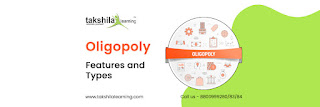Oligopoly meaning - CA Foundation Notes
The phrase oligopoly is made up of two words: oligo means few and polein means to sell. Competition among the few is a well-known definition of oligopoly. This means that there are only a few sellers in this market. In this market, the few vendors impact the behaviour of other enterprises, and each seller is influenced by the behaviour of fellow sellers. The market consists of products that are either homogeneous or differentiated.
Example of Oligopoly
In India, a few companies (Maruti, Tata, Hyundai, Ford, Honda, and so on) dominate the automobile business. A change made by one company (say, Tata) in one of its vehicles (say, Indica) will cause other companies (say, Maruti, Hyundai, etc.) to make changes in their corresponding models.
Features of oligopoly
Only a few businesses
This market structure contains a small number of significant enterprises. However, the number of firms is not specified. Each company contributes a share of the total output. Various firms compete with one another. To outwit one another, each corporation tries to vary its prices and volume of output. Because the number of firms is so small, each firm's actions have an impact on the rival firms. As a result, each firm maintains a close eye on the activities of competitors.
Interdependence
This market's firms are interlinked. Interdependence implies that the acts of one firm have an impact on the actions of other firms. A change in output or pricing by one firm causes other enterprises to react.
Read more Features of oligopoly and Types of oligopoly
Must read
Tag - what is oligopoly; oligopoly examples; types of oligopoly; features of oligopoly; CSEET study material; CA foundation notes

Comments
Post a Comment
Thank you we will contact ASAP.